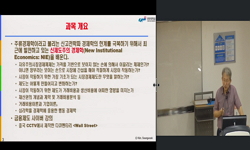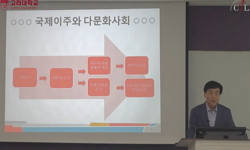이 연구의 목적은 일본에서 외국인의 증가에 따른 출입국관리정책의 전환과 그 의미를 고찰하는 데 있다. 특히 일본 정부의 신제도로서 ‘특정기능’의 도입 배경과 특징을 분석하고 이를 ...
http://chineseinput.net/에서 pinyin(병음)방식으로 중국어를 변환할 수 있습니다.
변환된 중국어를 복사하여 사용하시면 됩니다.
- 中文 을 입력하시려면 zhongwen을 입력하시고 space를누르시면됩니다.
- 北京 을 입력하시려면 beijing을 입력하시고 space를 누르시면 됩니다.

일본 출입국관리정책과 외국인노동자 수용의 신제도 ‘특정기능’ 도입에 대한 고찰 = A Study on the Specific Functions of Japan s Immigration Policy as a New System for Receiving Foreign Labors
한글로보기https://www.riss.kr/link?id=A107823623
- 저자
- 발행기관
- 학술지명
- 권호사항
-
발행연도
2021
-
작성언어
-
-
주제어
이민정책 ; 외국인노동자 정책 ; 특정기능 ; 신제도 ; 인구감소 ; Immigration Policy ; Foreign Labor Policy ; Specific Functions ; New System ; Population Decline
-
KDC
300
-
등재정보
KCI등재
-
자료형태
학술저널
-
수록면
151-170(20쪽)
-
KCI 피인용횟수
0
- DOI식별코드
- 제공처
-
0
상세조회 -
0
다운로드
부가정보
국문 초록 (Abstract)
이 연구의 목적은 일본에서 외국인의 증가에 따른 출입국관리정책의 전환과 그 의미를 고찰하는 데 있다. 특히 일본 정부의 신제도로서 ‘특정기능’의 도입 배경과 특징을 분석하고 이를 통해 한국에서의 외국인 수용정책에 대한 시사점을 제공하고자 한다. 연구결과는 다음과 같다. 첫째, 일본에서 외국인 정책전환의 배경에는 아베 정권의 아베노믹스 추진결과에 따라 일본경제가 개선되는 과정에서 성장에서 분배로의 경제적 선순환이 전개되고 기업의 노동력 부족이 버블경제 이후의 수준까지 높아지는 상황에서 출현한 것으로 나타났다. 둘째, 일본 정부는 외국인노동력 부족 상황에 직면하여 2019년 특정기능의 체류자격에 관련된 제도의 적정운용을 도모하기 위해 특정기능 체류자격에 관한 제도운영의 기본방침을 개정하였다. 셋째, 일본 정부의 특정기능 1호 신설에 따른 외국인 인재수용 예상자 수는 개호업이 가장 많았고 다음으로 외식업, 건설업, 빌딩청소업, 농업, 음식료품 제조업 순으로 높게 나타났다. 넷째, 일본 정부는 ‘특정기능’ 신제도 도입을 통한 외국인 인재수용을 본격화하면서 동시에 이들에 대한 지원사업도 적극적으로 시행하고 있는 것으로 나타났다. 결론적으로 일본 정부의 신제도로서 외국인수용정책의 전환은 기능실습에서 외국인노동자로의 이행을 전제로 하는 것으로 외국인노동자 정책의 근본적인 정책전환은 아닌 것으로 나타났다. 그러나 이 제도는 인구감소시대 유입된 외국인노동자의 장기간 안정적 정착 제도의 도입과 사회적으로 공생 사회의 실현이 중요해지고 있는 시점에서 신제도가 도입되었고 외국인노동자에게 전업의 자유, 노동조건 정비, 사회보장제도가입 등을 적극적으로 추진하고 있다. 이 연구는 향후 한국에서도 인구감소시대 이민정책의 전환과정에서 귀환 동포(중국동포, 고려인 등)의 수용과 사회통합의 정책 방향설정에 중요한 시사점을 제공할 수 있을 것으로 생각된다.
다국어 초록 (Multilingual Abstract)
The purpose of this study is to examine the change in immigration policy and its meaning in accordance with the increase in the number of foreigners in Japan. In particular, the purpose of this study is to analyze the background and characteristics of...
The purpose of this study is to examine the change in immigration policy and its meaning in accordance with the increase in the number of foreigners in Japan. In particular, the purpose of this study is to analyze the background and characteristics of the introduction of specific functions as a new system of the Japanese government, and to provide implications for foreign immigration policy in Korea. The research results are as follows. First, in the background of foreign policy transition in Japan, the economic cycle from growth to distribution develops in the process of improvement of the Japanese economy following the Abe administration s promotion of Abenomics, and it appears in a situation where the labor shortage of companies rises to the level after the bubble economy. Second, in the face of the shortage of foreign labor force, the Japanese government revised the basic policy on the operation of the system related to the status of residence for specific skills in 2019 in order to promote the proper operation of the system related to the status of residence for specific skills. Third, the nursing care industry accounted for the largest number of foreign talent recipients following the establishment of specific skills by the Japanese government, followed by restaurant industry, construction industry, building cleaning industry, agriculture, and food and beverage manufacturing industry. Fourth, the Japanese government is actively accepting foreign talents through the introduction of a new system for ‘specific skills’, and at the same time actively implementing support projects for them. In conclusion, the introduction of the new system of the Japanese government s policy for accepting foreigners was introduced at a time when the introduction of a long-term stable settlement system for foreign workers brought in an era of population decline and the realization of a symbiotic society became important. In the future, it is expected that it will be able to provide important implications for setting the policy direction for returning Koreans during the transition process of immigration policy in the era of population decline in Korea.
목차 (Table of Contents)
- Ⅰ. 연구목적 Ⅱ. 일본 출입국관리 신제도 ‘특정 기능’의 등장과 도입 배경 Ⅲ. 외국인 인재수용의 ‘특정기능’ 신설의 효과와 다문화 공생의 종합적 대응 Ⅳ. 결론 및 시사점
- Ⅰ. 연구목적 Ⅱ. 일본 출입국관리 신제도 ‘특정 기능’의 등장과 도입 배경 Ⅲ. 외국인 인재수용의 ‘특정기능’ 신설의 효과와 다문화 공생의 종합적 대응 Ⅳ. 결론 및 시사점
참고문헌 (Reference)
1 梶田孝道, "顔の見えない定住化ー日系ブラジル人と国家・市場・移民ネットワーク" 名古屋大学出版会 2005
2 日本経済再生本部, "経済財政運営と改革の基本方針 2018~少子 高齢化の克服による持続的な成長経路の実現~"
3 柏崎千佳子, "移民政策 のフロンティア日本の歩みと課題を問い直す" 明石書店 22-, 2018
4 白石勝己, "留学生数の変遷と入管施策から見る留学生 10 万人計画" 財団法人アジア学生文化協会 61 : 2006
5 文部科学省, "留学生 30 万人受け入れ計画骨子"
6 井口太, "東アジア経済統合下の外国人労働者受入れ政策" 7 (7): 9-26, 2015
7 日本経済再生本部, "未来投資 戦 略 2017 ―Society 5.0 の実現に向けた改革―"
8 浅香幸枝, "日系人の受け入れ支援-中南米日系社会との連携の視点から-" 93 : 20-21, 2018
9 出入国在留管理庁, "新たな外国人材の受入れ及び共生社会実現に向けた取組"
10 寺倉憲一, "我が国における留学生受入れ政策―これまでの経緯と「留学生 30 万人計画」の策定―" 697 : 27-47, 2009
1 梶田孝道, "顔の見えない定住化ー日系ブラジル人と国家・市場・移民ネットワーク" 名古屋大学出版会 2005
2 日本経済再生本部, "経済財政運営と改革の基本方針 2018~少子 高齢化の克服による持続的な成長経路の実現~"
3 柏崎千佳子, "移民政策 のフロンティア日本の歩みと課題を問い直す" 明石書店 22-, 2018
4 白石勝己, "留学生数の変遷と入管施策から見る留学生 10 万人計画" 財団法人アジア学生文化協会 61 : 2006
5 文部科学省, "留学生 30 万人受け入れ計画骨子"
6 井口太, "東アジア経済統合下の外国人労働者受入れ政策" 7 (7): 9-26, 2015
7 日本経済再生本部, "未来投資 戦 略 2017 ―Society 5.0 の実現に向けた改革―"
8 浅香幸枝, "日系人の受け入れ支援-中南米日系社会との連携の視点から-" 93 : 20-21, 2018
9 出入国在留管理庁, "新たな外国人材の受入れ及び共生社会実現に向けた取組"
10 寺倉憲一, "我が国における留学生受入れ政策―これまでの経緯と「留学生 30 万人計画」の策定―" 697 : 27-47, 2009
11 外国人研修生権利ネットワーク, "外国人研修生 時給 300 円の労働者2" 明石書店 2009
12 法務省入国管理局, "外国人材の受入れについて"
13 自治行政局国際室, "外国人材の受入れと地域における多文化共生施策の現状等"
14 井口泰, "外国人労働者新時代" ちくま新書 2009
15 日本経済調査協議会, "外国人労働者受入れ政策の課題と方向―新しい受入れシステムを提案する―"
16 外務省, "中南米日系社会との連携に関する有職者懇談会報告書" 8-9, 2017
17 外国人集住都市会議, "いいだ 2011 会議資料"
동일학술지(권/호) 다른 논문
-
- 한국정치사회연구소
- 김송죽(Kim Song-Juk)
- 2021
- KCI등재
-
인공지능 기반 사회를 대비한 미국의 AI 전략과 정책 : AI R&D 분야를 중심으로
- 한국정치사회연구소
- 홍석훈(Hong, Sukhoon)
- 2021
- KCI등재
-
- 한국정치사회연구소
- 이기완(Lee Li-wan)
- 2021
- KCI등재
-
- 한국정치사회연구소
- 박봉규(Park, Bonggyu)
- 2021
- KCI등재





 KCI
KCI 스콜라
스콜라







